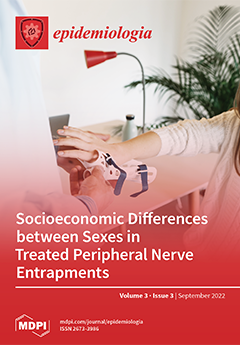Open AccessArticle
Incidence, Hospitalization, Mortality and Risk Factors of COVID-19 in Long-Term Care Residential Homes for Patients with Chronic Mental Illness
by
Alberto Arnedo-Pena, María Angeles Romeu-Garcia, Juan Carlos Gasco-Laborda, Noemi Meseguer-Ferrer, Lourdes Safont-Adsuara, Francisco Guillen-Grima, María Dolores Tirado-Balaguer, Susana Sabater-Vidal, María Gil-Fortuño, Oscar Pérez-Olaso, Noelia Hernández-Pérez, Rosario Moreno-Muñoz and Juan Bellido-Blasco
Cited by 1 | Viewed by 2314
Abstract
Long-term care residential homes (LTCRH) for patients with chronic mental illness have suffered the enormous impact of COVID-19. This study aimed to estimate incidence, hospitalization, mortality, and risk factors of COVID-19 to prevent future epidemics. From March 2020 to January 2021 and before
[...] Read more.
Long-term care residential homes (LTCRH) for patients with chronic mental illness have suffered the enormous impact of COVID-19. This study aimed to estimate incidence, hospitalization, mortality, and risk factors of COVID-19 to prevent future epidemics. From March 2020 to January 2021 and before vaccination anti-SARS-CoV-2 begins, cumulate incidence rate (CIR), hospitalization rate (HR), mortality rate (MR), and risk factors of COVID-19 in the 11 LTCRH of two Health Departments of Castellon (Spain) were studied by epidemiological surveillance and an ecological design. Laboratory tests confirmed COVID-19 cases, and multilevel Poisson regression models were employed. All LTCRH participated and comprised 346 residents and 482 staff. Residents had a mean age of 47 years, 40% women, and suffered 75 cases of COVID-19 (CIR = 21.7%), five hospitalizations (HR = 1.4%), and two deaths (MR = 0.6%) with 2.5% fatality-case. Staff suffered 74 cases of the disease (CIR = 15.4%), one hospitalization (HR = 0.2%), and no deaths were reported. Risk factors associated with COVID-19 incidence in residents were private ownership, severe disability, residents be younger, CIR in municipalities where LTCRH was located, CIR in staff, and older age of the facilities. Conclusion: COVID-19 incidence could be prevented by improving infection control in residents and staff and modernizing facilities with increased public ownership.
Full article






